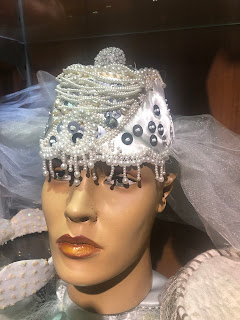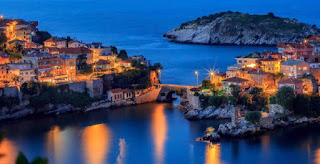Cappadocia, Konya and Pamukkale: Chapter Three
DAY FOUR of our trip saw us saying goodbye to the wonderful host of our hotel in Urgup, as we headed for Konya, a three-hour drive away.
Our first stop was a tropical butterfly museum, not exactly high up on my personal bucket list but nevertheless, it proved very interesting, with the friendlier species willing to land on your hand. It's very hot inside, though. It's the biggest butterfly flying field in Europe. Trip Advisor gives it four and a half stars out of five and you can learn more by clicking here.
We had lunch in the Turbeonu restaurant. The Okra soup was delighful at 60TL. And lamb "tandir" was a mere 140TL. Next, it was off to the Mevlana complex, the home of the Whirling Dervishes, a short walk away. It's not a museum, so entry is free and it's well worth a visit.
Chandelier
Tomb
Mevlana's tomb
Grave
We were soon heading to Catalhoyuk, a World Heritage site. This was a Neolitic settlement, founded around 7500BC and lasting until 6400BC. It was first discovered by an Englishman James Mellaart in 1958. He led excavations from 1961 until 1965. Mellaart was later banned from Turkey in a scandal over missing Bronze Age artefacts, The site stood dormant until 1993 when British archeologist Ian Hodder resumed excavations.
It is estimated 10,000 people lived here in mudbrick homes. They grew wheat and made bread. They also cooked indoors. Relatives were often buried under the house. You can learn more here
Human remains
Excavations
Copies of wall paintings
Seated goddess flanked by two feline lionesses
We stayed overnight in the Novotel in Konya. Our room was like a Turkish sauna and it was impossible to open the window. We had to call room service. Even the handyman could not fix the heatwave. It felt like we were back in the butterfly museum. When we finally got to sleep we found the hotel is very close to the loudest muezzin in Turkey. An ear-splitting call to prayer woke us up in the middle of the night. On the plus side the buffet breakfast was superb.
Day Five saw us drive towards Denizli. The first stop was at an old han which was under repair. But behind the han was an enormous sinkhole.
Han (photo by Ann Kennedy)
Sink hole (photo by Ann Kennedy)
Our next destination was Pamukkale/Hierapolis. I had been here many years ago but was worried by recent reports that the wonderful tiers of calcium were not as beautiful as before....and so it proved. They were rather dirty. Entry (if you did not have a Turkish Muze Kart) was 500TL, more even than Ephesus.
Pamukkale
Pamukkale
Pamukkale
In fairness, the ruins of Hieropolis fully made up for the disappointment. Originally a Phrygian cult centre to the Goddess Cybele, it later became a Greek city. The nearby hot springs were always an attraction and the spa is believed to date back to the 2nd century BC. The most famous tomb on show is that of Marcus Aurelius Ammianos.
Day six (our final day) saw us drive towards Kusadasi, But there were wonders in store on the way. First up was Laodikeia. The town was originally called Diospolis (City of Zeus). The city was founded on the site of an older town by Antiochus II Theos, king of the Seleucid Empire.
Main street Laodikeia
Main street Laodikeia
Theatre
Your blogger
More ruins
We stopped for lunch at a small, local restaurant. The food was excellent but the main attraction was a dancing parrot. Check it out here
Or cut and paste the URL below...
Incredibly, the ruins at Laodikeia were to be surpassed when we reached Aphrodias. They were discovered completely by chance by a young photographer in the
1950s driving to Aydin to photograph a new dam. He lost his way and
ended up in a village called Geyre. As he sat there, drinking tea
with the locals, he noticed houses built with odd-looking stones.
Villagers shrugged their shoulders, said the stones had always been
there and were amused at his excitement. He took photographs and
eventually contacted the famous Turkish photographer Ara Guler, who
alerted a Turkish archaeologist Prof Kenan T. Erim from New York
University. Erim came to Turkey and quickly realised that the
photographer had accidentally discovered the lost city of
Aphrodisias. From that day Erim dedicated the rest of his life to
excavation work. He died in 1990, but the Turkish government rewarded
his dedication by burying him within the ancient city, next to the
Tetrastoon, the gates welcoming pilgrims on their way to pay
sacrifices at the Temple.
You can learn more about Aphrodisias here
or copy this URL into your browser https://whc.unesco.org/en/list/1519/
The stadium
The stadium
The stadium
Guide Volkan explains the origins of theatre masks
(photo by Gabriel Grace)
Ruins at Aphrodisias
Ruins at Aphrodisias
Sarcophagus at Aphrodisias
Sarcophagus at Aphrodisias
Medusa figure on a sarcophagus at Aphrodisias
put on to dissuade robbers
Theatre mask
No need for forensics here. Remains in the museum
From the museum at Aphrodisias
A bride and groom showed up for a photoshoot
From the museum at Aphrodisias
From the museum at Aphrodisias
From the museum at Aphrodisias
From the museum at Aphrodisias
So that concludes my three-part blog on our six day tour. I hope it gives you some idea of the attractions on offer in this part of Turkey and the prices of entry to tourist spots and the cost of meals. Thank you so much for reading my blog.
If you would like to know more about Turkish culture, history, food and living in Turkey....please check out my book Twelve Camels for your Wife (on Amazon) which has sold more than one thousand copies and has more than 110 five-star reviews on Amazon. Check it out here or cut and paste the URL tinyurl.com/kktvp25p








































We oved Konya
ReplyDeleteAs usual a fantastic read I felt I was there with you while reading it .
ReplyDelete